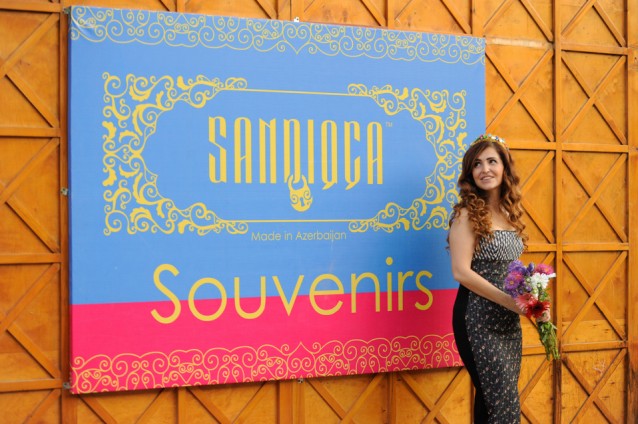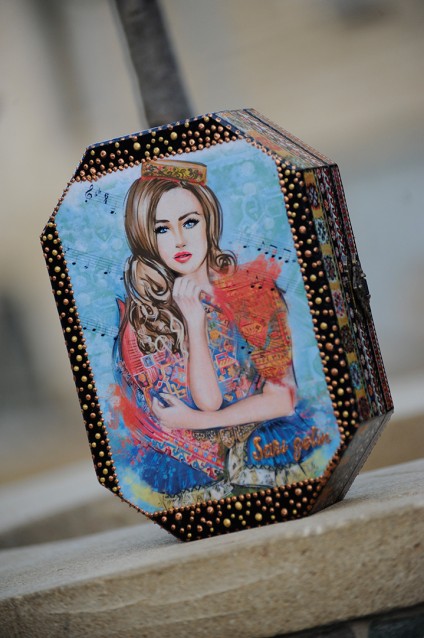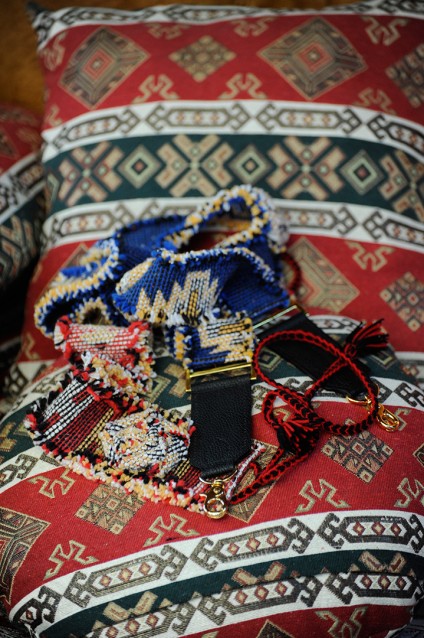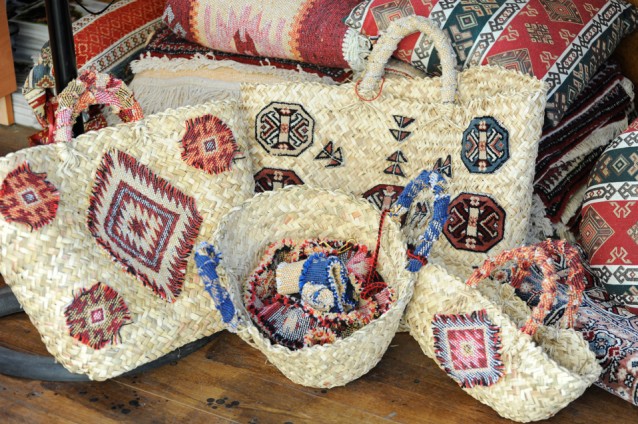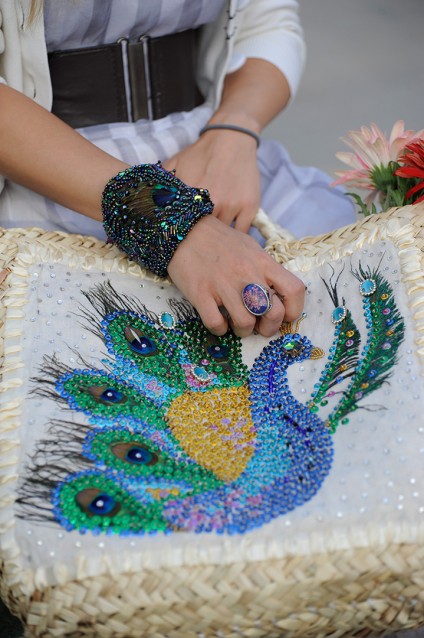Souvenirs, for some just an optional feature of a vacation, are for others a certain necessity and at times the most significant element of one’s overseas experience. In part it has to do with the place you’re visiting, which in the case of Azerbaijan will undoubtedly make one want to have a physical reminder. Rana Yuzbashi’s small stand at the inspirational, historical heart of the city – Icheri Sheher – definitely has a fairytale vibe to it.
Despite being open for only three months, she has quite the collection of unique items that attract attention from not only guests of the city, but also local Bakuvians. Reviving old Azerbaijani craft traditions like intricate weaving techniques and lace knitting – Ms Yuzbashi is aiming for the stars. But before diving into the world of Sandiqcha (‘small trunk’ in Azerbaijani) treasures, let’s say a little about the enigmatic lady behind them.
I’ve already gotten used to Baku being a place where you get to meet incredibly talented people who each time give a new definition to the word creativity. Rana Yuzbashi is no exception to that and on what seemed like the hottest day this summer we met at, in my opinion, one of the most beautiful parts of our city: Istiqlaliyyat Street. If you’re ever in Baku, visit this area first and you’ll be amazed by how organically buildings of different styles and time periods come together.
It all started with a dream – Narmin’s recollections
It always amazes me how people bloom within and through the ordinary professions that they initially choose for themselves. After graduating from Baku State University (BSU), one of the oldest universities in the East, the first university in the Caucasus and the first to accept women, Rana khanim continued her education at the European Peace University in Austria, worked for international organisations and then came back to BSU to teach.
Co-author of this article Narmin was in fact a former student of Ms Yuzbashi and recalls her as: a beaming woman with short straight hair always warmly welcoming students – you never forget such a face. She taught ethno-political science and that was all I knew about her until a few years ago. I started reading her posts on social media, discovering a new Rana Yuzbashi for myself, with a massive following of people who loved her writing. A few months ago, I saw a post announcing Sandiqcha’s opening and even from the little information available at the time, it was clear that these souvenirs were unlike any other. Sandiqcha souvenirs have stories to tell people.
I saw right there and then that both Sandiqcha and Visions were essentially working towards the same goal, striving to let people know how unique and rich our culture is and also to tell the world the truth about occupied Azerbaijani lands. I knew we needed to meet her right away.
After deciding to leave BSU, Rana’s life began moving in a completely different direction: I had a dream to write a book. And I thought it was a perfect time for doing that – it was a bit of a midlife crisis, I had just turned 30 and I thought this was the time to do something interesting.
Rana, the writer
People often ask me where I get the stories from and I want to say that they are everywhere, all you need to do is be open to them. The best plots for books are based on the everyday stories around us. ‘‘All the world’s a stage’’, Shakespeare wrote, and I feel like an observer. I’m not talking about being nosy or peeping into private matters, but when the story is unfolding in front of me, I cannot stop myself from observing.
Before diving into the world of marketing, PR and advertising in 2013, with which she hopes she will never fall out of love, Rana was quickly becoming a well-known name within writers’ circles both in Baku and in Moscow. Shortly after publishing her third book, Skinhead, in Moscow, she moved there and immersed herself in writing scripts for Russian TV channels. It was an invaluable experience, but it exhausts you after a while. Feeling profoundly empty, she left fame and her writing career behind and returned to Baku.
Ever since that script writing experience, I haven’t written anything longer than a Facebook status. I cannot find the willpower to come back to writing yet, but everything in its own time I believe. Maybe it will happen, maybe it won’t. But I have to tell you one thing. In order for me to write–I have to be unhappy. And, mashAllah, I’m so happy now, and maybe that’s why I don’t feel the need to reflect anything in writing.
Sandiqcha, the idea
The idea about souvenirs stemmed from a simple question from a couple of tourists at the Fairmont gym where she and they were working out one day. Where can we get authentic Azerbaijani souvenirs? they asked. The first thing that comes to mind is Icheri Sheher, which is exactly what Rana suggested, only to find out that the slightly confused tourists did not find anything even remotely resembling Azerbaijan on generic magnets and key-chains with Central Asian motifs. Determined to help them, she spent all next day on the phone, which culminated in a shocking admission that, indeed, there wasn’t a single place in Baku where an assortment of various kinds of souvenirs (made in Azerbaijan) were available for purchase.
For me, one of the biggest treasures of Azerbaijan is its culture. And not being able to share that with the visitors of the country seemed like one of the biggest omissions on our part.
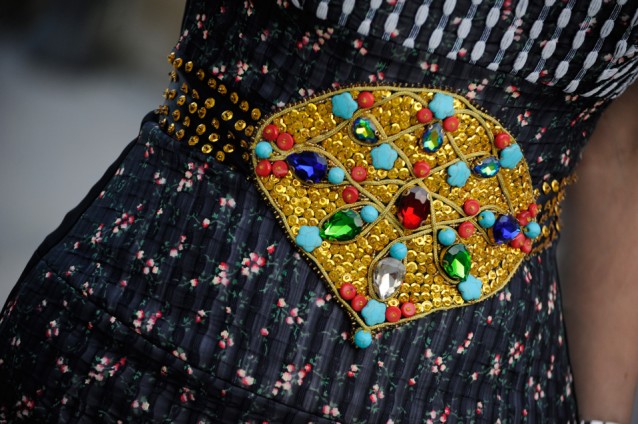 Kemer Yagut – a belt embellished with natural turquoise, coral, Czech rhinestones, paillettes and beads
Kemer Yagut – a belt embellished with natural turquoise, coral, Czech rhinestones, paillettes and beads
Around that same time, Ms Yuzbashi was invited to an event at the carpet museum where she gazed longingly at a now very important carpet for her – an ovchuluq (Shirvan region).
And all I could think about was – I want a jacket with national ornamentation like this. Given that I’m very inspired by fashion, I knew finding a jacket like this would be impossible, but I didn’t want this desire of mine just to stay a wish.
That was a pivotal moment in the decision to create Sandiqcha: At the beginning I was thinking of Sandiq (trunk), but the image was too awkward. So because I’m very petite myself and I like things that are petite, I thought Sandiqcha (little trunk) had a better sound to it.
And the Reality
That initial spark was followed by an algorithm of decisive steps that Rana took in the direction of her dream, the first of which was a planning session with a financial specialist. Within three weeks, with the help of Demir Bank and her personal investments, enough money was gathered for the start of production. And here’s where Rana khanim’s approach differs from the rest:
I did not want to order anything and resell it. I’m a strong believer that the country should have its own production. Not a single factory in China will make the souvenirs with as much love and heart as we would in Azerbaijan.
Another important point, she utilizes the talents of people who have inherited the knowledge, those who know all the secrets of crafts like applied arts, knitting, painting on glass but who cannot find outlets for their knowledge. Some of them she met very randomly, like the knitter Letafet khala, whom she met through a lady she saw in a supermarket and whose jacket she loved so much she had to find out who made it. That effectively accomplishes one of the other aims Rana had in starting her small business – providing the older population with work.
A lot of women have the ability, they know the craft, but they don’t know the current trends in fashion. For example, in applying the skills of our talented lace knitter, we’re now making lace scarves that are always stylish and interesting.
Sandiqcha fashion
I love fashion, and I love it as part of art, not because something is just fashionable. I love fashion where you can feel the soul of the creator.
Underlining the appeal of folk art on famous international brands, she went through a brief history of Hermès’ transition from being an ordinary village craftsman making saddles for horses to becoming a major brand in the handbag industry, and noted that the origins of the beloved Gucci’s bamboo collection were the shortage of materials during World War II.
She talks with adoration about all of her creations, but the special love for book clutches is definite: I love books and I love bags with Azerbaijani motifs, carpet motifs.
The clutches are made according to leading international practice – out of plywood, because they have to be light.
The concept of Sandiqcha, as it appears to me, is the fusion of one creative individual’s love of Azerbaijan, fashion and willingness to create something for her motherland. Because, essentially, this is Rana telling the story of Azerbaijan through each item that they sell. And indeed, while giving Visions a tour and displaying her pride and joy, each treasure had a story interwoven into the history of its region.
Her love of fashion again shines through as she goes through the very detailed process of creating national, motif-infused woollen belts for handbags: This has been practised before by Burberry with English motifs, or Fendi based on Italian folklore; the belts were first introduced by Fendi, then Burberry, Valentino, etc. Following the experiences of famous fashion brands, she nonetheless strives to always represent Azerbaijan in her creations.
One of the other main aims for Sandiqcha was to modernize Azerbaijani crafts, to make them competitive on the market, to adjust them to today’s reality. Sebet (basket) can turn into an original handbag, and not only a cute basket for the beach.
Sebetler – basket handbags
Among the absolute bestsellers at Sandiqcha are the lovely sebets, or baskets usually used at farmers’ markets for fruit or veggies, creatively transformed into original handbags with handmade carpet pockets, all very delicate and intricate. The inspiration behind it? D&G’s straw hats, decorated with gemstones and bright materials.
The idea of such baskets is not new of course: But they aren’t as original and affordable as mine, said Rana. The price varies according to size and type of weaving, 35 AZN being the most expensive one. The handle of the sebet is wrapped with kilim (flatweave) carpet, because it has to be soft.
The shop is very honest about the two types of sebets that are sold: one with one hundred per cent handmade carpet pockets and the other fully decorated with carpet mosaics.
Those carpet mosaics are machine made, because a lot of carpet goes into that sebet, and if we made them all by hand, the price could be as high as 200 AZN. Making money is important, but one of the main aims for me personally is to tell the story of Azerbaijan’s culture. That’s why I’m trying to make the prices affordable.
As we looked through the variety of souvenirs on those enchanting shelves, I noticed how much attention is paid to the carpet elements in everything, from handbags, scarves to jewellery. I could not help but ask for her favourite school of carpet weaving:
Tabriz. It’s always stories, always miniatures. And especially for me as someone just fascinated by stories. I’m in love with Southern Azerbaijan, Tabriz carpets for me are the most beautiful ones.
Business End
Incredibly dedicated to her small business, sometimes opening the stand at midnight for those who have forgotten to do their holiday shopping, she also trains each and every one of her salespeople, so they can represent the brand properly. Rana shared that starting a business takes a lot of responsibility and much of your personal life, but in the end, it’s all for a good cause.
Because I started this business with so much love for Azerbaijan, I keep telling my daughter, love me, but love Azerbaijan more than you love me. Our motherland we have to love more than we love our family, because family is part of the motherland. And if I miss out on something in my family, I realise that what I am doing is directly and indirectly for my family – my motherland.
Postscript
Sandiqcha has also released a set of postcards that are given out free with every purchase made in the store. The set is called Azerbaijan, Shusha, 2025: We drew Shusha under the Azerbaijani flag, hoping that by 2025 we’ll see Shusha free and peaceful, under its home country’s flag, with all the people who haven’t seen their home in a quarter of a century returning home.
Talking to Rana Yuzbashi is always educational, invigorating and inspirational. She has a gift for filling the conversation with seemingly small details that create an incredibly full and rich impression, just like the highly detailed ornaments of her pretty peacock sebet. It is such a joy that a year ago a simple question jumpstarted her creativity and led to Sandiqcha, where even at the smallest level, we are telling the world about Azerbaijan and about its brightest jewel – our culture.